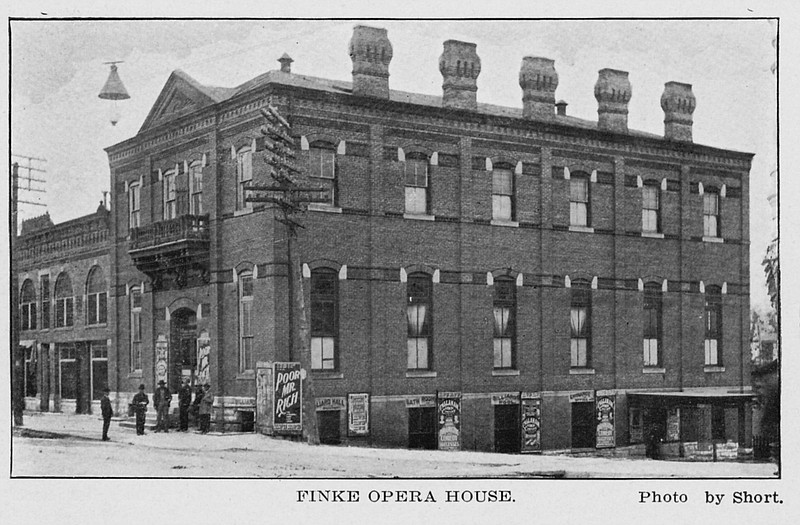CALIFORNIA, Mo. -- The Finke Theater today hosts local musicians and performers, as well as out-of-town professionals, just as it was designed to do in 1885.
The shell has seen significant changes, but the value to the community has endured.
The corner building served as the community's only opera house for plays, music and vaudeville, and then its only movie theater, showing movies through 1978.
"As an entertainment center, the multi-use building provided a variety of recreation opportunities for residents of California and the surrounding area for more than ninety years," the nomination said.
Interest in theater appeared to grow with an increase in discretionary income and leisure time as the work week shortened from 60 hours in 1890 to 51 hours in 1910 and to 47 hours in 1920.
The late 19th century has been called the "golden age of the professional stage" in Missouri. Performances by well-known actors, lecturers and musicians emphasized education, culture, respectability and moral encouragement in family-type programs.
On a broad cultural perspective, the opera house provided a focal point for a community's public persona, the nomination said.
"Courthouse, city halls, churches, schools, along with theater or opera house buildings, stated by the their size and elegance that the community had arrived, that it had moved from frontier outpost to settled, civilized community," the nomination continued.
The first performance after completion in August 1885 was given by Professor Lenzen's music class. Blind Boone, the African-American pianist from Warrensburg, played camp meeting songs and his own "The Marshfield Cyclone" in 1893.
In 1909, former outlaw Cole Younger gave a lecture explaining why he was forced to live an outlaw's life and detailing his experiences. And California's Aurora High School used the site for graduations until it added its own auditorium in 1929.
Originally built as a multi-use facility, the theater was a two-story, brick with the main floor as the opera house, the basement for a billiard hall and the upstairs for fraternal orders meeting room.
St. Louis architect Jerome Legg designed the building in the late Victorian/Eclectic style, according to the National Register of Historic Places nomination. Then, it was remodeled in 1937 with an Art Deco facade.
While The Heritage of Missouri suggests "the small town "opera house' was usually little more than a barn-like structure with a stage," the Finke Opera House was a well-appointed two-story brick building in designed in 1885, the nomination said.
When built, the dressing rooms were behind the stage, but in 1888, they were moved to the basement to add 8 feet to the stage space.
Seating for 600 included box seats on either side of the stage and a horseshoe balcony wrapped round three sides of the hall. Gaslights and chandeliers provided light and a pump organ, found in the basement, likely provided accompaniment to the performances.
Organizations which used the upstairs meeting room included the Lodge No. 183, A.F. & A.M. and the I.O.O.F plus their auxiliaries and the Loyal Rebekah Lodge. The floor was divided in two with the Masonic Lodge using the north side and the Odd Fellows and Rebekahs using the south.
By the time the town built the theater in 1885, California had 10 dry goods stores, two drug stores, a tobacco factory, a printing office, a steam flourmill, a carding mill, a high school, a wool mill, a cheese factory, the Moreau Paper Mill, several potteries, two banks, and a building and loan company. The population was about 1,500 and boasted amenities including a fire department and an artesian well.
Henry Finke, who arrived in 1850 from Cincinnati, was responsible for much of the town's business growth. He used his skill as a tailor until opening the Finke Mercantile Company, building the town's first brick business building. And he opened the state's first paper mill. While also operating a large farm and selling timber to the railroad, Finke held several city and county offices.
Finke was the treasurer of the Opera House Company, which organized in 1884. After raising the funds, the company members visited area opera houses including Sedalia, Nevada and Butler for ideas.
Dr. J.H.P. Gray bought the Opera House company in 1888, when it was sold at the courthouse under a deed of trust. A second stock company was organized to manage the property and Henry Finke again was elected treasurer, the nomination said. Finke's son William bought out the other investors in 1895 to become the sole owner.
William Finke's wife and daughter took over the business upon his death in 1925, by which time it was solely a motion picture house. They sold to M.J. Nash and Henry Holloway of St. Louis in 1937, when the name changed to the Ritz Theater and the remodeling was done by St. Louis architect O.W. Steigmeyer.
The St. Louis architect remodeled the facade to the popular Art Deco style in 1937. Seven chimneys were removed, as was the exterior balcony. Access to the second floor from the outside was added. The main entrance was lowered to street level and widened to double doors. A large electric sign naming the "Ritz Theater" was added to the east side canopy.
In the 1930s remodel, the theater floor was sloped toward the stage, making the basement unusable. And the original stage was removed for more seating. To ensure the required darkness for motion pictures, north-facing windows were bricked over.
The 1937 remodel also replaced the gaslights with decorative electric fixtures.
After sitting vacant for a few decades, the California Progress Inc. restored the brick icon, which again serves as an entertainment hub for the community.

